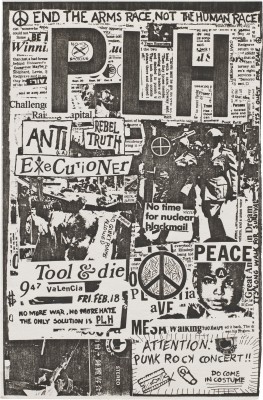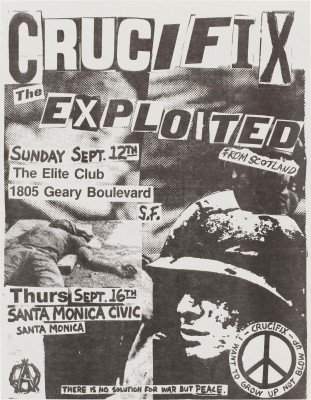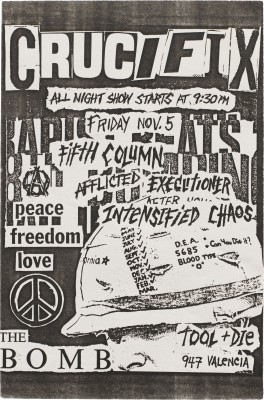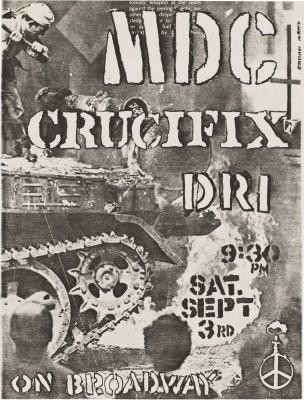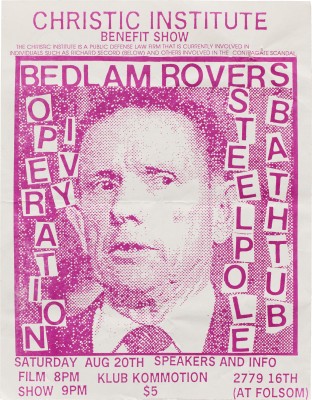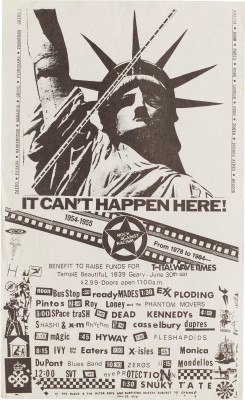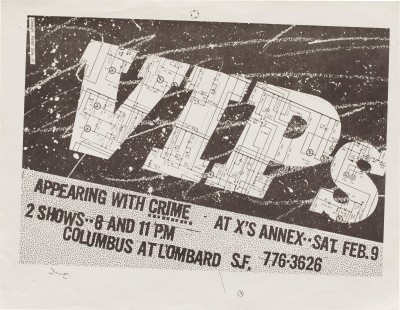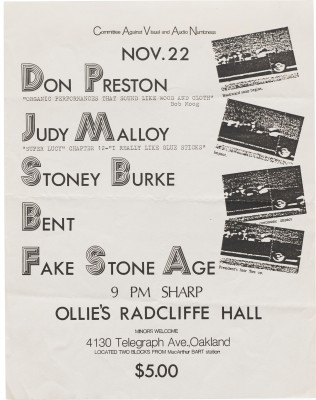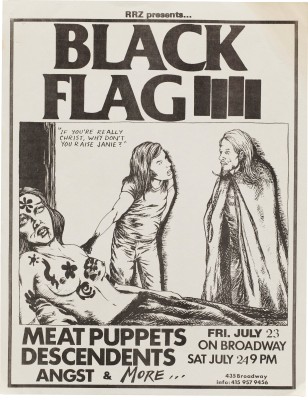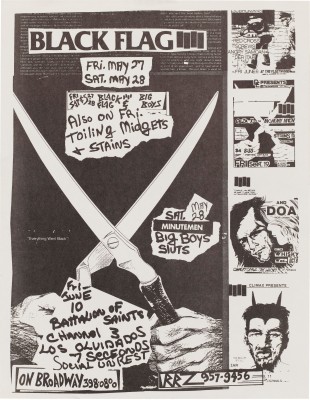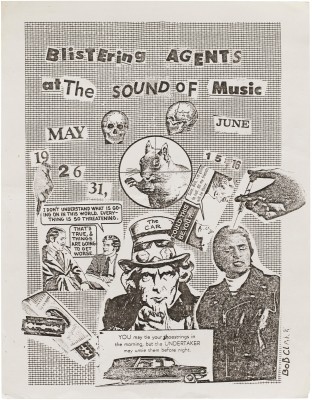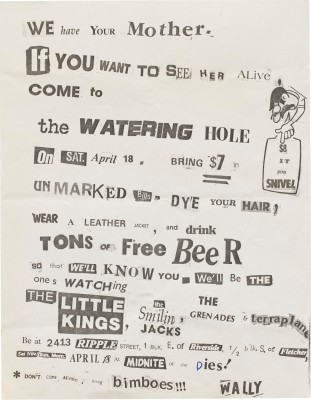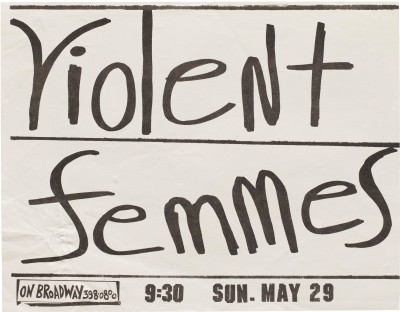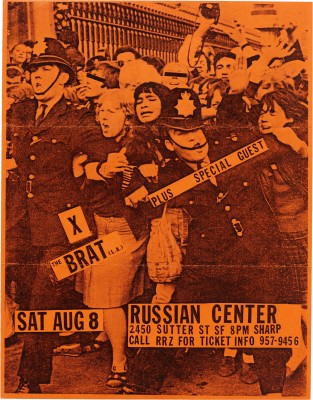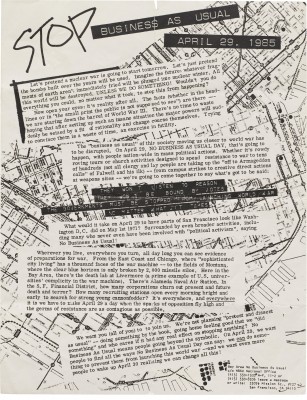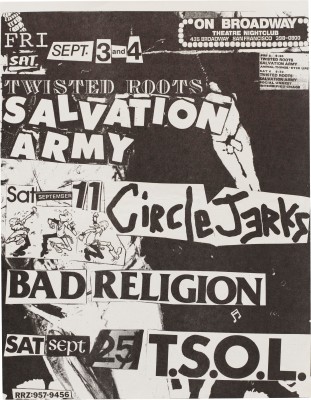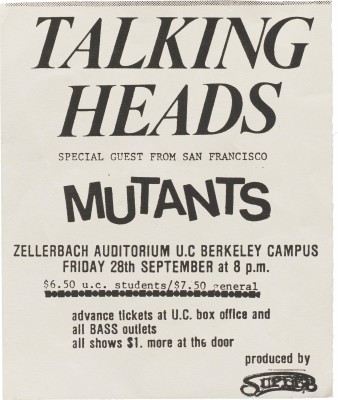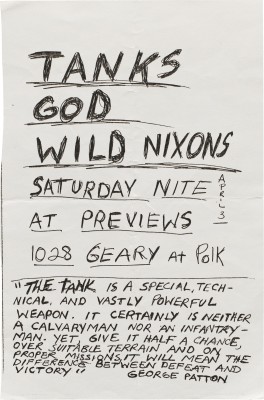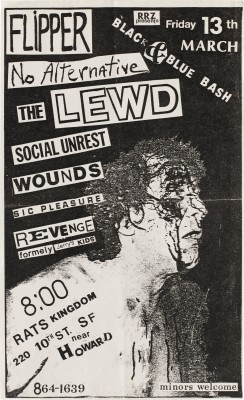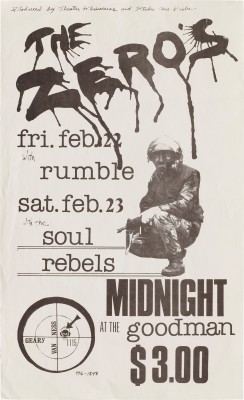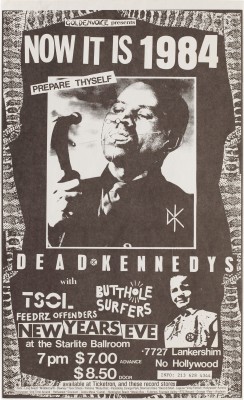News
This Just In: Punk Flyers of the Bay Area
Our new collection offers a visual explosion of the 1970s–80s punk scene in Berkeley, Oakland, and San Francisco.
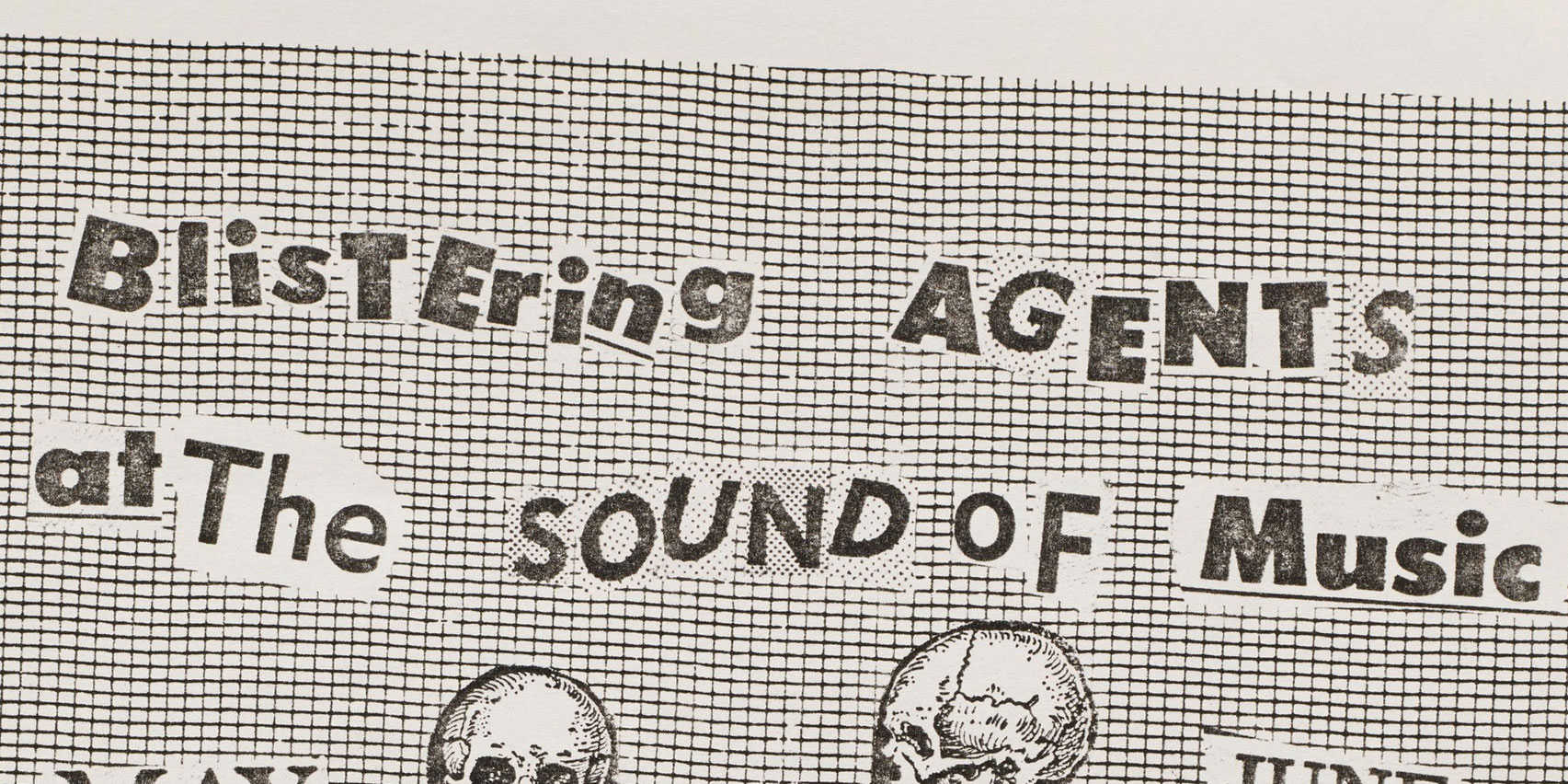
Punk has always been anti-establishment, and that includes the traditional design establishment. Its ethos is DIY; make do with what’s available, and figure it out. Don’t have the necessary supplies? Doesn’t matter; you can make paste from flour and use a public library’s xerox machine. Punk thumbs its nose at the polished. It embraces the messy, the handmade, and the authentic. It is a state of mind reflected both in the sound of its music and the look of its promotional graphics.
As a movement, punk was a response to a malaise within creative musical circles that had begun to brew in the late 1970s. There was a fatigue of excess, of stadium rock and disco, of drawn-out rock ballads, of endless guitar solos and packed, soulless arenas. Young musicians pushed against the popular notion of musician-as-celebrity. Punk historian Toby Mott described the shift in his book Oh So Pretty: Punk in Print 1976–1980:2
“Suddenly there was this ‘can-do’ attitude and this exciting music that had a sort of unskilled approach. Everyone could do something. Also punk didn’t have that distinction between superstars like with Bowie or Led Zeppelin – everyone was on the same level. It wasn’t about worshiping a hero and conceiving a product, it was culture everyone participated in; whether you made the music, or made a fanzine or clothing.”
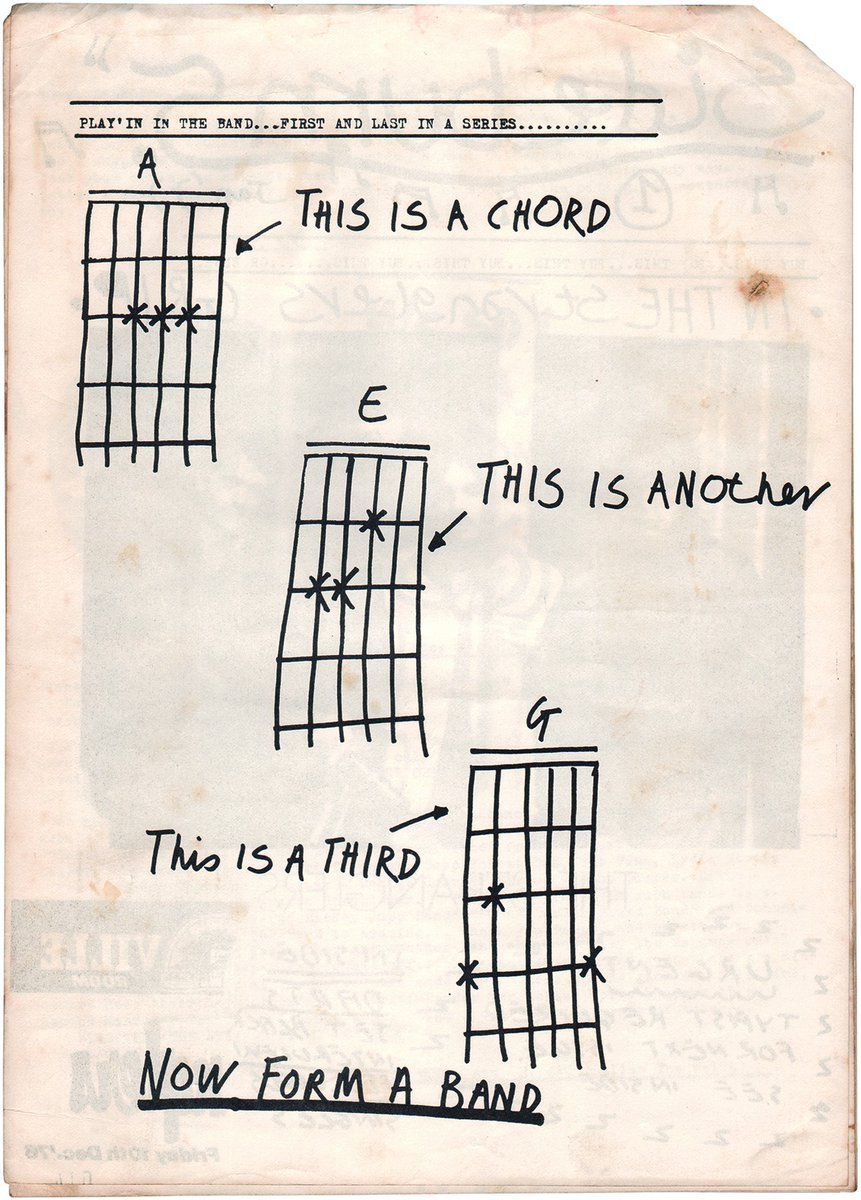
The UK zine Sideburns #1, published in January 1977, ran with this theme when creator Tony Moon filled the back cover with, “This is a chord. This is another. This is a third. Now form a band.” A call to action if there ever was one.2
The new DIY attitude, paired with a new conservative administration in the White House, was an environment ripe for creative explosion. Ronald Reagan became the face of the backlash against 1980 counterculture.3 Some Americans demanded a return to “traditional family values”, and an idealized 1950s life (and the associated racism and sexism that went along with it). It seemed, for a moment, as if all the social progress made during the ’60s and ’70s was fading. The nation was backpedaling in a desperate effort to return to a mid-century utopia that never existed. As Vic Bondi, of the band Articles of Faith, describes:1
In the early ’80s, there was a sense of re-establishing “the order”. The white man — Ronald Reagan — order is coming back. You know you had that wimp Jimmy Carter talking about peace and human rights and all this other shit and you had the feminists and the negroes and they’re all getting uppity on us, right? So we’re gonna reinstate order here, right? And so the whole country goes into this really puerile ’50s fantasy where they’re dressing in these cardigan sweaters and we were just like, “Fuck you. Not us. You can take that and shove it up your ass.”
![Left: Flyer for the Nuclear Heroes at Ollie’s Radcliff[e] Hall, Berkeley, 1982. Right: Flyer for Flipper at the Graffiti, San Francisco, 1984.](https://letterformarchive.org/wp-content/uploads/legacy/Nuclear_Heroes_Flipper.jpg)
The music scene was ripe for a grassroots movement that embraced the amateur, that eschewed corporate rock sensibilities, and the aesthetics that went with them. Cut-and-paste, rub-down type, magic marker and ballpoint pen, photomontage, early computer graphics, and fuzzy reproductions — the more handmade, the messier, the better. If you included a halftone image of a ’50s businessman in a wool suit, or a collage mocking the president, then bonus points to you.
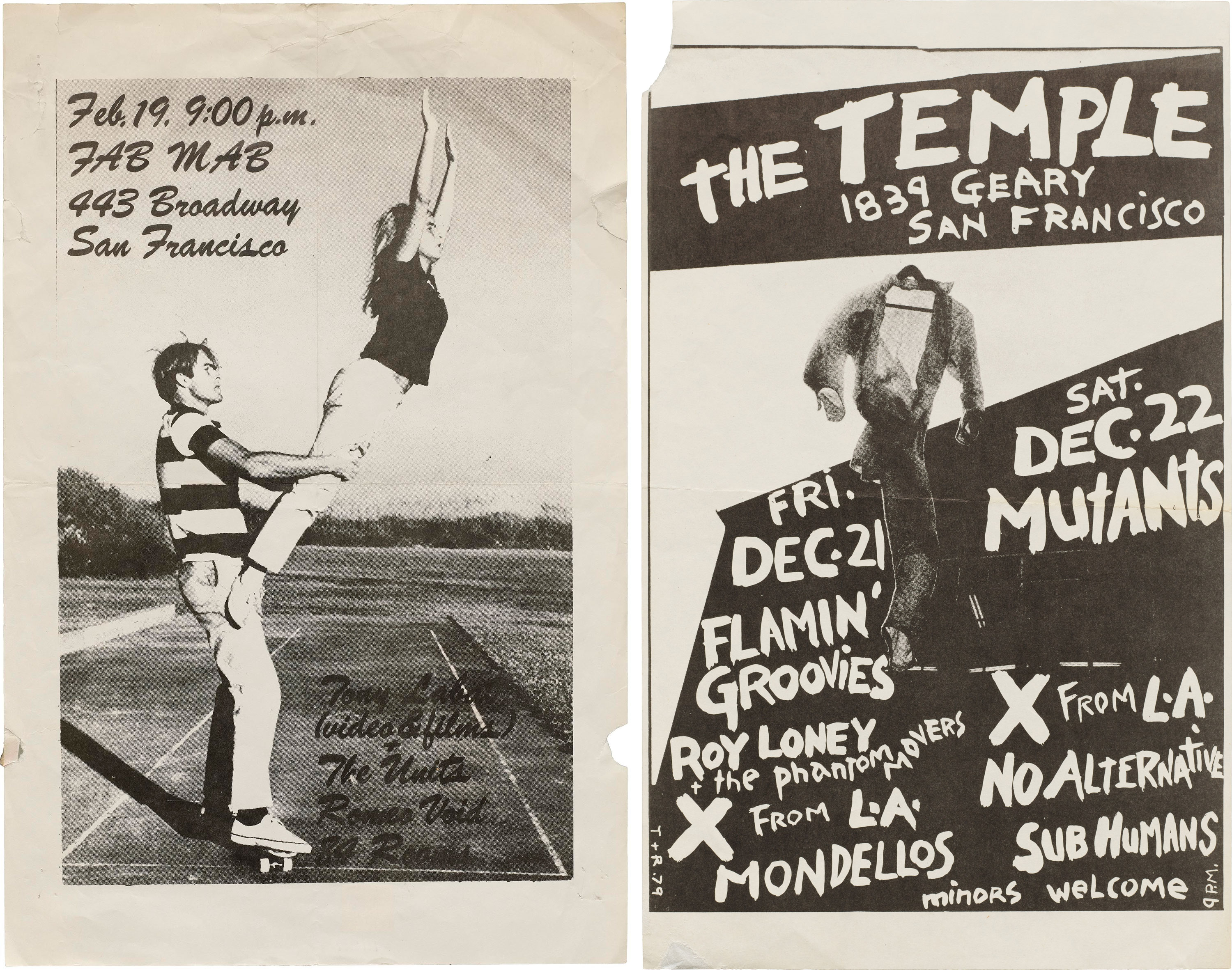
The collection that just arrived at Letterform Archive includes about 140 small posters (mostly 11 × 17 inches), flyers (8.5 × 11 and 8.5 × 14 inches), and handbills (smaller than 8.5 × 11 inches) for bands and venues integral to San Francisco Bay Area culture. Many advertise shows at the Mabuhay Gardens (pronounced Mah-boo-high, a greeting in Tagalog; colloquially known as “The Mab” or “The Fab Mab”). Owner Ness Aquino originally booked Filipino musicians at the supper club, but after the Philippines fell under the dictatorship of Ferdinand Marcos, he began to book punk acts to pay the rent. Although now defunct, the North Beach venue housed legendary acts such as Dead Kennedys, X, Black Flag, and The Go-Gos.4
Another featured venue is The Temple (aka Temple Beautiful) at 1839 Geary. The stunning synagogue built in 1906 turned into a music venue in the 1970s (intact architectural features like pews and Stars of David included). Adding to the anachronistic setting was the fact that The People’s Temple (of Jim Jones fame) was next door.5 Temple Beautiful’s glory was short-lived, as ownership changed hands throughout the 1980s and the building was destroyed in a fire in 1989.
Adding to the list of peculiar clubs was The Farm, an autonomous zone and collectively owned cultural space featuring a farm, a communal kitchen, school, and yes, a punk rock venue. Founded by Jack Wickert and Bonny Sherk, it was located between Army and Potrero Streets, an abandoned plot of land that once housed a dairy. Upon demolition of the Borden Dairy building, it was founded as Crossroads Community.6 Neighborhood children tended the garden and cared for farm animals, adults cooked and made art, and punks sang and danced. It functioned as a community space from 1974 until eviction in 1987 (though the majority of punk shows were played from 1983–86). The site is now La Raza park, and still has a community garden.6
Many of the flyers are political in a tongue-in-cheek way — notable figures are mocked, cut-up, disfigured, and stuck inside paper TVs and nuclear catastrophes of their own making. Other promotions are more overtly activist, advertising benefit shows for non profits like Refuse and Resist!, a human rights group co-founded by “Yippie” leader Abbie Hoffman,7 and the Christic Institute, a public interest law firm that represented journalists injured while investigating the Iran-Contra affair.8 There’s a very visible and palpable fear of nuclear war here; it’s the depths of the cold war and the threat of annihilation is everywhere. Meanwhile, death was a consistent part of every day life as AIDS was beginning to ravage queer communities. A flyer for the band Crucifix surrounds a peace sign with the words, “I want to grow up, not blow up”. Another, for the band PLH (Peace Love Happiness), says, “End the arms race, not the human race”. The band MDC (Millions of Dead Cops) shouted a motto at their shows, “No War / No KKK / No Fascist USA!” Later, this slogan was modified by Green Day at live shows with “No Trump / No KKK / No Fascist USA!”.9 “Rock Against Reagan” and “Rock Against Racism” became regularly running punk festivals throughout the 1980s.
Content warning: some items in this collection contain strong language, nudity, and depictions of violence.
All images in the gallery below are hi-fi captures. Click an image to enter fullscreen view, then pinch or use browser zoom to enlarge.
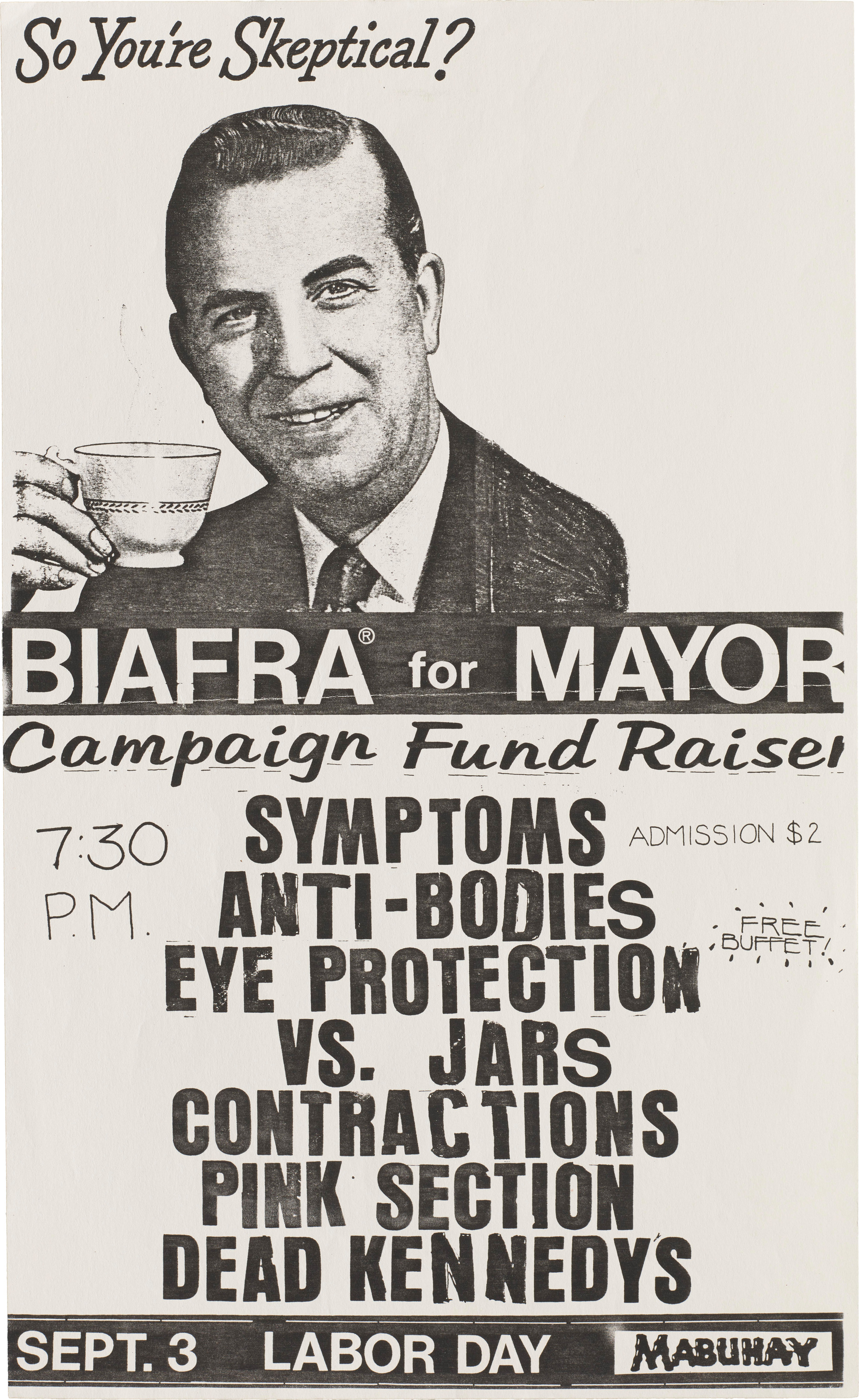
Some flyers, like Biafra for Mayor, are both absurd and sincere at the same time. Jello Biafra (a name derived from a combination of the nutritionally void dessert and the region of Nigeria which had just experienced a devastating famine) was frontman for punk band Dead Kennedys, and did in fact run for mayor of San Francisco in 1979, playing a benefit show at the Mabuhay to raise campaign funds.3 Biafra’s platform included the silly (forcing businessmen to wear clown suits) and the sincere (requiring police officers to run for election in the neighborhoods they patrolled). While he lost to Dianne Feinstein — coming in 4th, with 3.79% of the vote — he went on to become an active member of the Green Party and ran for President in 2000 with VP candidate Mumia Abu-Jamal.10
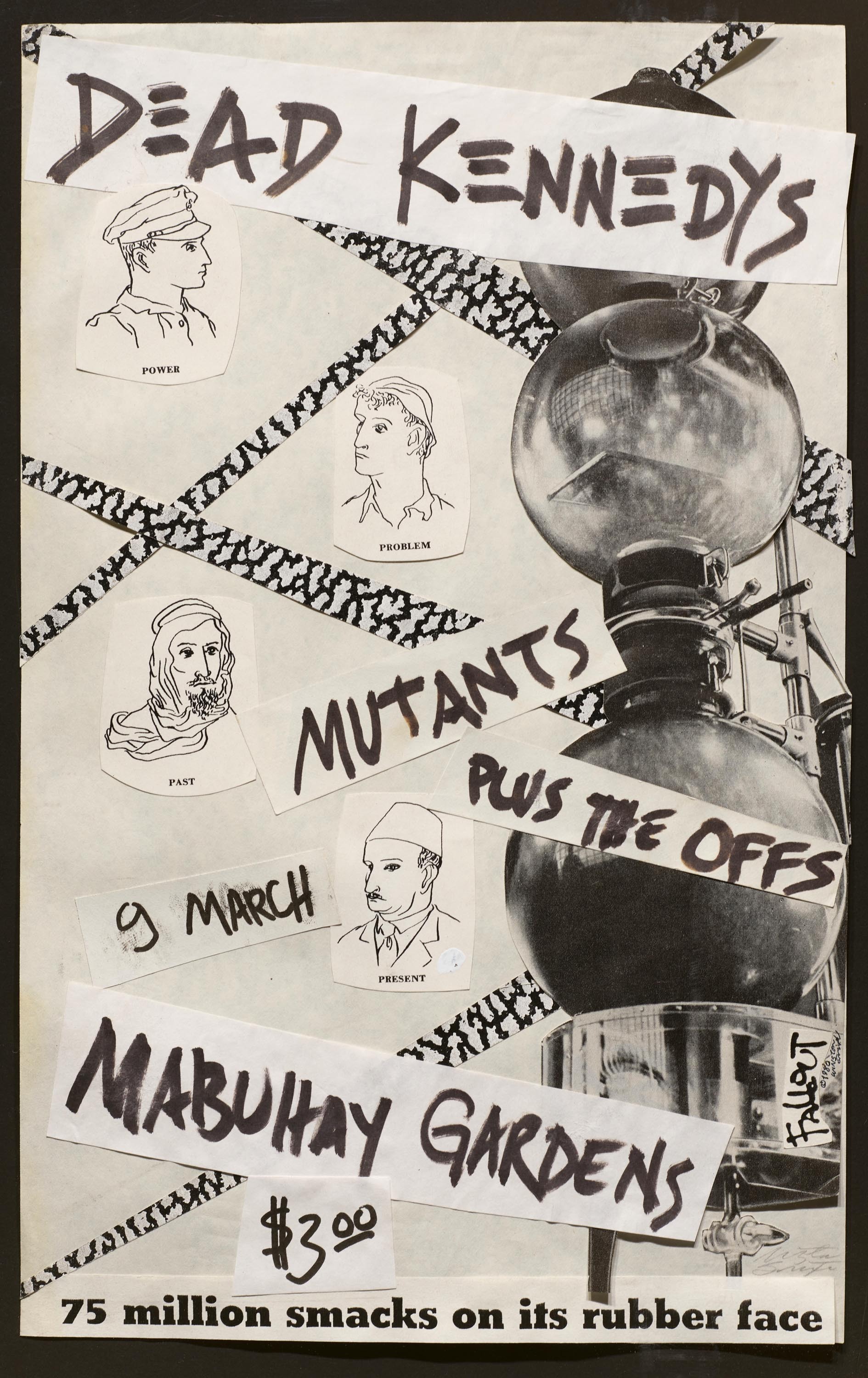
The Biafra for Mayor poster was designed by friend and collage artist Winston Smith (also a pseudonym, taken from the protagonist of George Orwell’s 1984). Smith frequently created pieces for Jello Biafra and Dead Kennedys, including their red and black “DK” logo. He used pieces from mid-century ads and magazines, perverting the 1980s suburban fantasy and turning it on its head. Gleeful and dripping in surrealism, Winston said, “A lot of the artwork at the time looked very much like the dada period. Things just cut out of something else and slapped together.”11 A few flyers (and a later Dead Kennedys album) show a man’s face surrounded by barbed wire and superimposed over a photograph of corpses. The main image was taken from a 1950s Barbasol shaving cream ad, and the background is a photo from a famine in Calcutta in 1946.12 Shock and disgust was the goal.
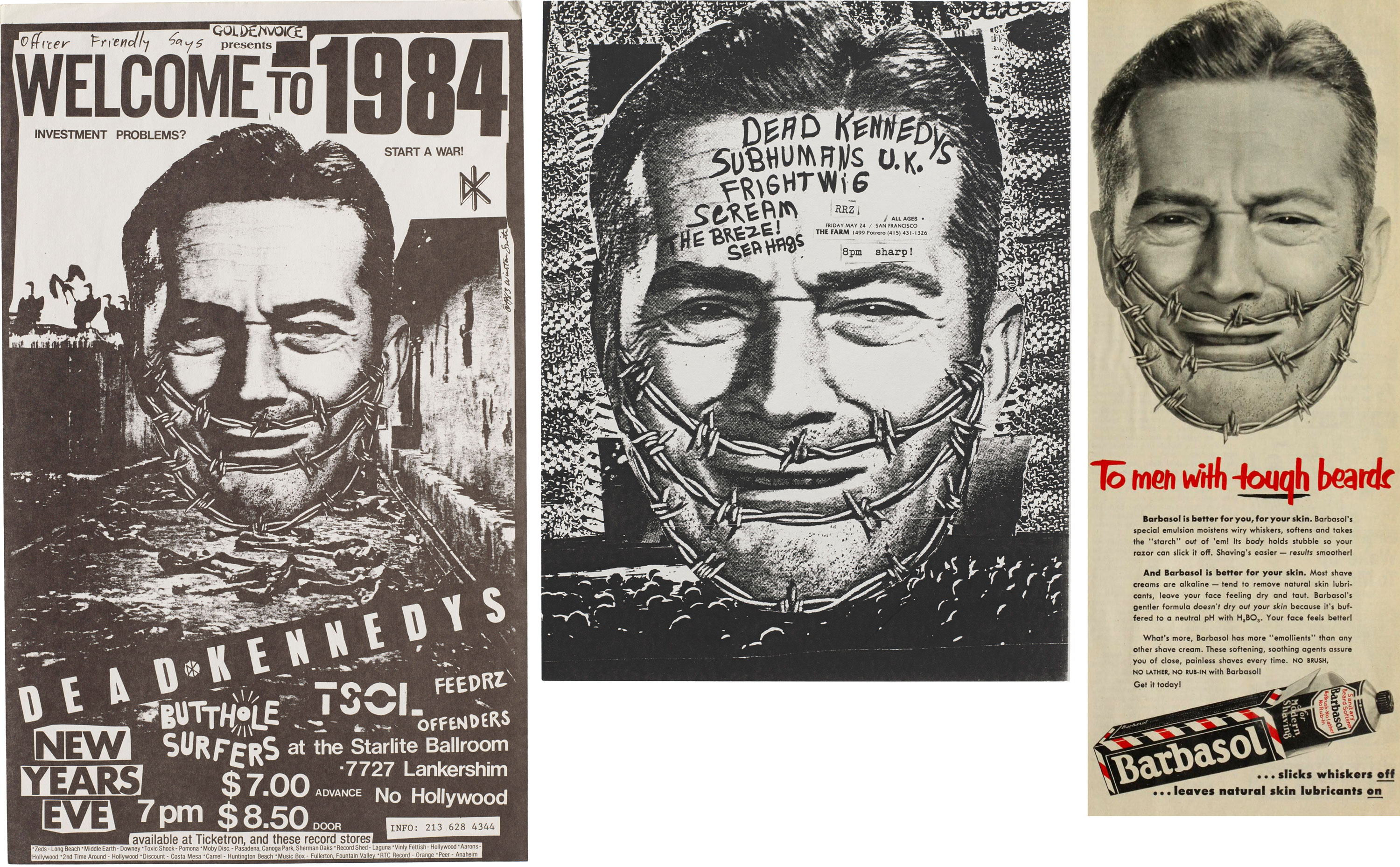
“From the very beginning, punk’s visual art was deliberately simple, DIY, anybody could make it if you had a demented enough brain. All it took was scissors or a razor blade and some glue, and you could make collages…One wicked idea, especially one that’s going to offend everybody who sees it, that’s the way to go.” — Jello Biafra
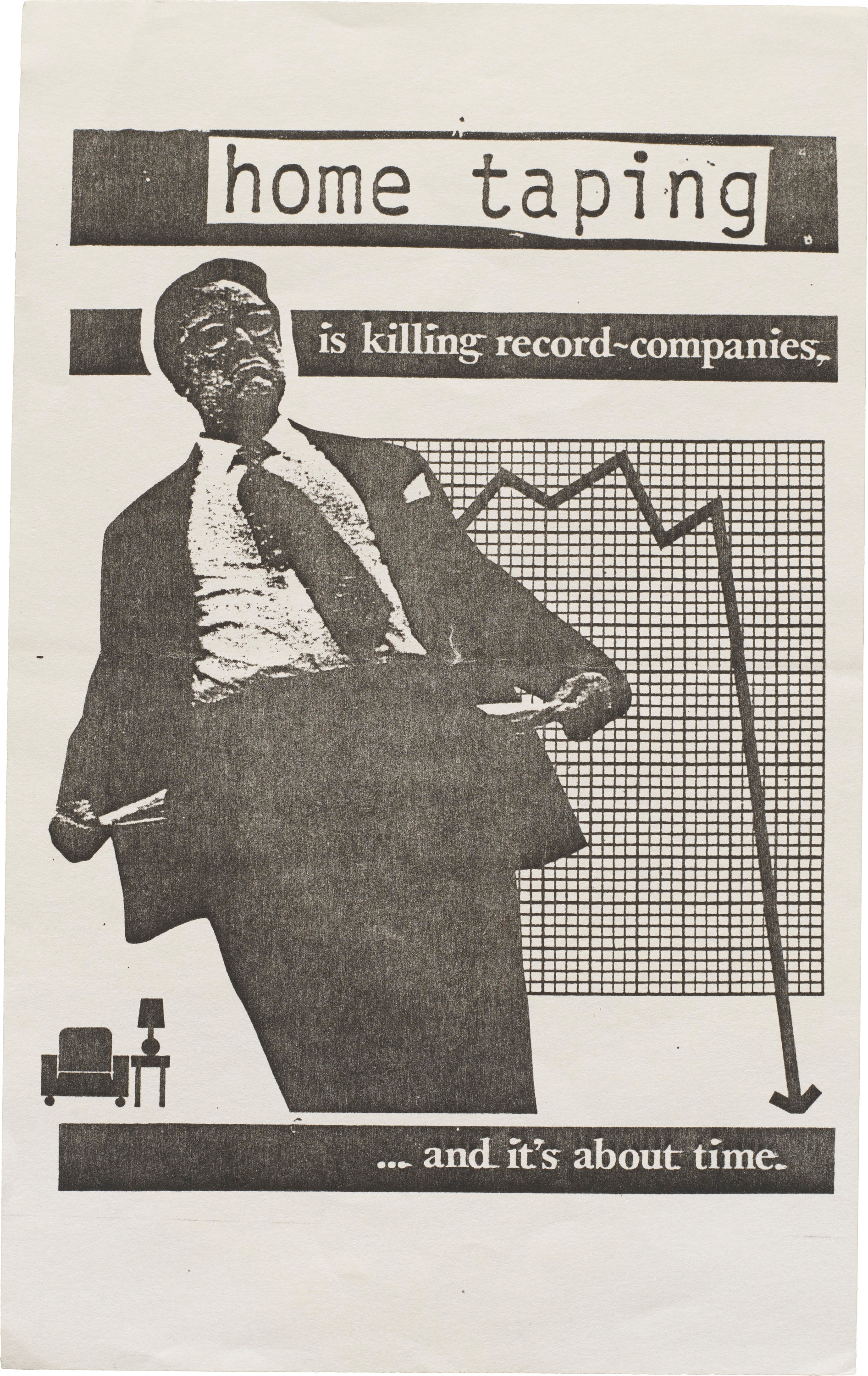
Smith and Biafra took another shot at decorum with the album In God We Trust, Inc., whose cover shows Jesus on a cross, covered in dollar bills. It was a response to the money-hungry televangelists that had become popular at the time, but it also poked fun at the recording industry and capitalism in general. The early 1980s was one of the least profitable periods for large record companies. Sales were declining rapidly, thought to be due to home record taping and music piracy.3 Released as a cassette, In God We Trust Inc. poked fun at corporate music’s panic. Purposely made with a blank side B, it read “Home taping is killing record industry profits. We left this side blank so you can help.”3 A flyer with a similar line, “Home Taping is killing the record industry…and it’s about time!” may have also been designed by Smith.
The collection includes a flyer by Raymond Pettibon, widely recognized for his Black Flag logo (four horizontal black bars at varying heights) and the Sonic Youth album cover, Goo. His work is strange, absurd, and political, borrowing style from comic books and poking fun at cops and the religious establishment. (Black Flag had an ongoing feud with the Los Angeles Police Department, who were constantly shutting down their shows and raiding their record label’s offices).3
Pettibon’s art can be incredibly dark. One flyer depicts a woman suffering from a drug overdose, and an onlooker’s powerlessness to stop it. It functions, perhaps, as a commentary on the casualties of 1970s drug culture. Pettibon’s raw, hand-lettered comic book style is in contrast to the fancy, swashed typography so often seen in the 1970s (à la Fleetwood Mac’s Rumours).
Ultimately, all the flyers in this collection reflect a disillusionment with the status quo, with American politics, and with everything professional, polished, and elite. The photocopied montages of type and image often reveal their roughly trimmed edges. In all their uneven lines and scrawled letters are attempts at finding the authentic, the raw, and the real.
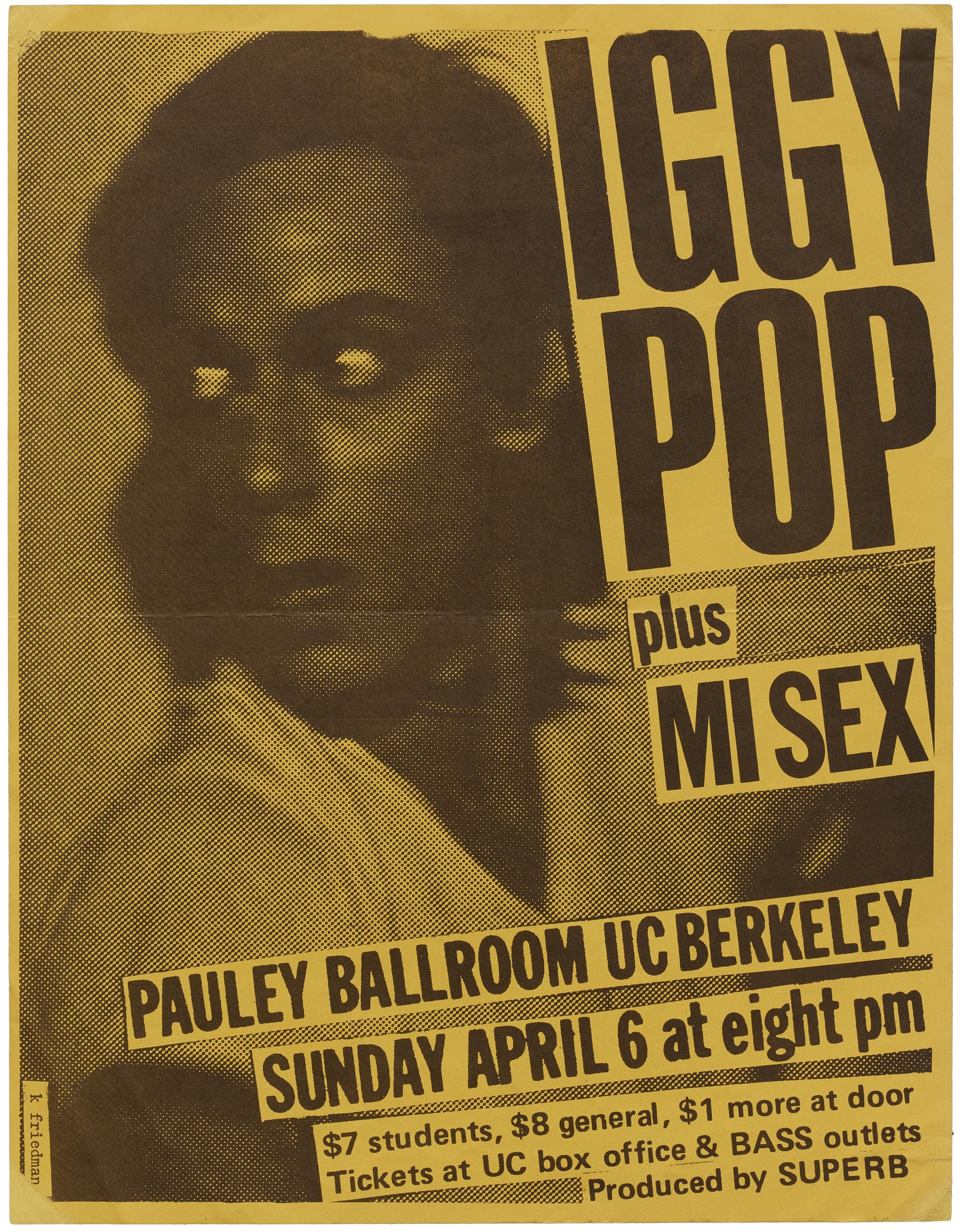
Punk legend Iggy Pop was notorious for cutting up his chest on stage and smearing it with peanut butter. It was gross, maybe, but at least it was the real thing.
— April Harper, Digitization Librarian
Punk Flyer Gallery
All images in the gallery below are hi-fi captures. Click an image to enter fullscreen view, then pinch or use browser zoom to enlarge.

